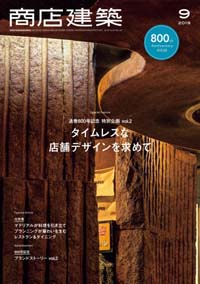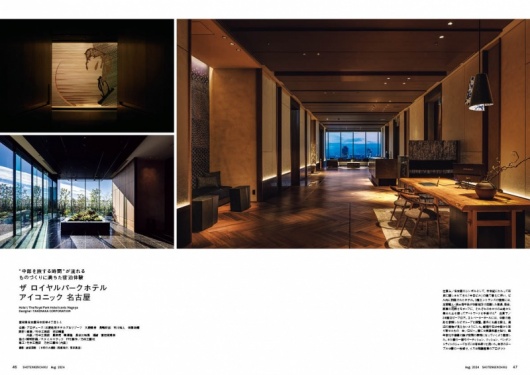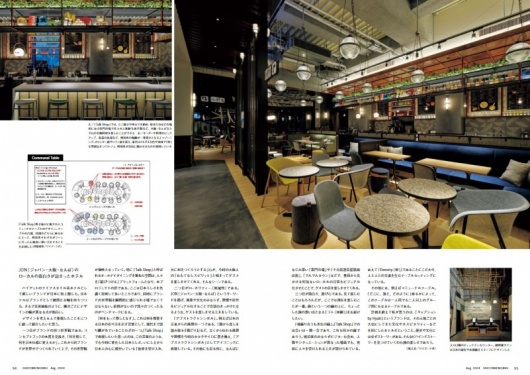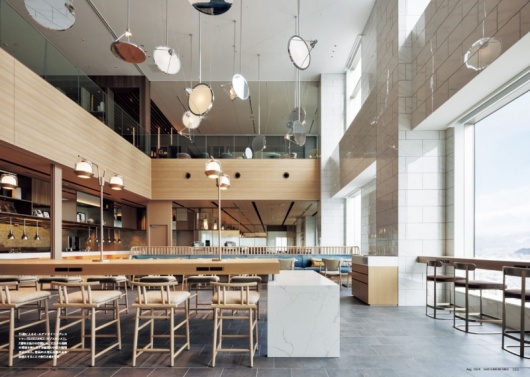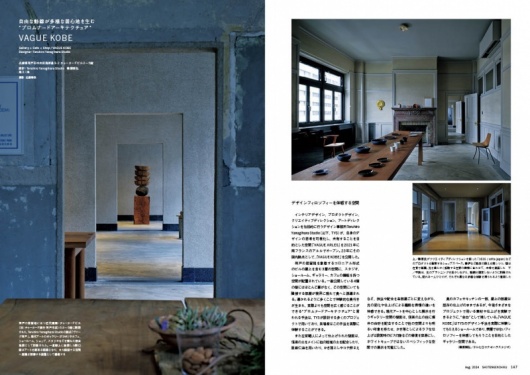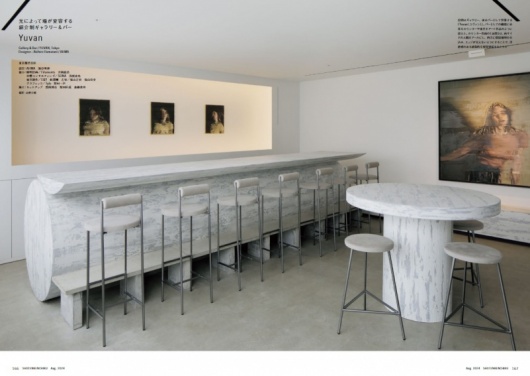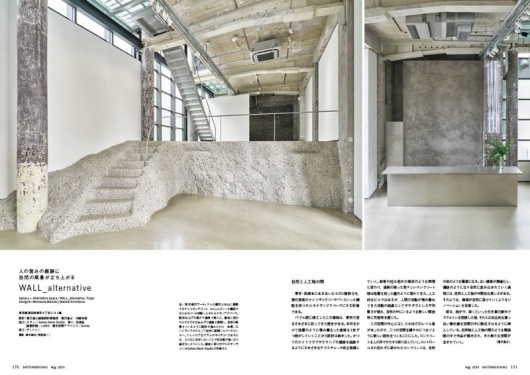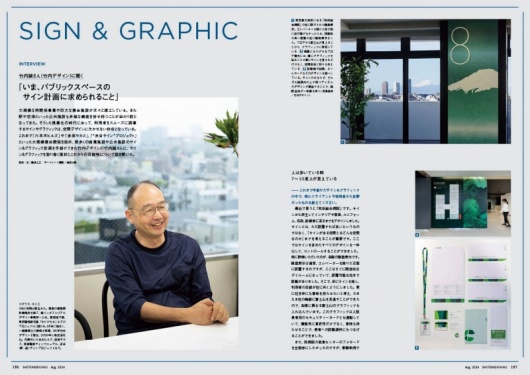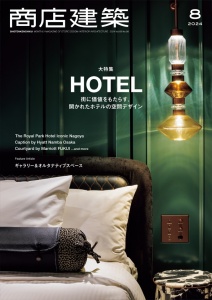SHOTENKENCHIKU /August
2024/07/26 2024

SHOTENKENCHIKU is monthly magazine of Japanese interior design / store design / commercial architecture
August 2024, SUMMARY
SPECIAL FEATUREPECIAL FEATURE
HOTEL
FEATURE ARTICLE
GALLERY & ALTERNATIVE SPACE
SPECIAL FEATURE
HOTEL
The Royal Park HOTEL Iconic Nagoya
(Page 46)
This hotel opened in Nagoya, Aichi, and was planned to embody
the Chubu region. The history of the Chubu region shows that
many warlords swarmed through this region during the Warring
States period, and the technology and culture that developed as
the center of the Tokaido Highway is still very much alive today,
In planning this hotel, the designers visited manufacturing sites
scattered throughout 10 prefectures in the Chubu region and
considered utilizing the handiwork of various craftsmen, such as
plasterers and Japanese paper, in the architecture. By
experiencing a space filled with such a craft atmosphere, guests
will gain a travel experience of the Chubu region.
Designer : TAKENAKA CORPORATION
SPECIAL FEATURE
HOTEL
Caption by Hyatt Namba Osaka
(Page 93)
Caption by Hyatt, a major U.S. hotel chain operated by Hyatt
group, has landed in Japan for the first time. Caption by Hyatt
features a space called “Talk Shop” that doubles as an all-day
dining service area and is planned as a platform to bring people
together.
At Caption by Hyatt Namba Osaka, “Talk Shop” and various other
artworks in the guest rooms and throughout the hotel are playfully
designed to visualize daily life in Namba, Osaka, incorporating
ancient Japanese customs and centered on the Caption by Hyatt
brand, which embodies culture and hospitality, The design
attempts to create a neighborhood experience based on the
“Caption by Hyatt” brand, which embodies culture and hospitality.
Designe : WISE LABO KUME SEKKEI
SPECIAL FEATURE
HOTEL
Courtyard by Marriott FUKUI
(Page 101)
The word that symbolizes Fukui Prefecture is probably "white," as
in the snowy landscape and Echizen washi paper. The whiteness
and beauty of the landscape and traditional culture are also
included there. Fukui’s deep snowy climate led to the development
of indoor industries such as Echizen Washi paper and textiles,
from which it has now developed into cutting-edge enterprises
such as eyewear and triaxial fabrics,
The old and the new coexist, weaving an identity story of Fukui.
However, it is not too appealing, and Fukui has a culture that is
deep, quaint, and modest, like a person who is the ideal image of
a Japanese person. The concept of this hotel is “elegant
simplicity,” and the aim is to create a hotel of high quality and
serenity, with details that are not ostentatious but have a Fukui
feel throughout.
Designer : FHAMS
SPECIAL FEATURE
HOTEL
VIP TALK: DESIGN STUDIO SPIN × ab concept
(Page 130)
A conversation with Yasuhiro Koichi of Design Studio Spin and Ed
Ng of AB Concept. The two, who have designed various luxury
hotels such as The Ritz-Carlton, Four Seasons, ANDAZ, and
Fauchon Hotel, discussed tips for designing luxury hotels in Japan
and the state of developers. Both men, who have worked on some
of the world’s best hotel brands, discussed the complexities of
hotel development in Japan and how the development side in
Japan needs to change. The two men had an interesting
conversation about the differences in awareness in Japan and
abroad, their perceptions of luxury, how they deal with design,
and various other factors.
FEATURE ARTICLE
GALLERY & ALTERNATIVE SPACE
VAGUE KOBE
(Page 146)
VAGUE KOBE is the base of Teruhiro Yanagihara Studio, a
design firm that comprehensively handles interior design, product
design, creative direction, and art direction. This base, located in
a modern building that symbolizes the Kobe Settlement area, has
a studio, gallery, showroom, café, and other functions, allowing
visitors to experience the studio's design thinking. While retaining
a colonial aspect, the walls are plastered with a different
expression for each room, softly diffusing the light coming in
through the windows. The space continues to change, leaving a
blank space for experimentation.
Designer : Teruhiro Yanagihara Studio
FEATURE ARTICLE
GALLERY & ALTERNATIVE SPACE
Yuvan
(Page 166)
This project is a coexistence of a gallery and a bar. A “tokonoma”
was created in the center of the space as a presence that
enhances the art, and the minimum necessary functions as a bar
were given to the fixtures, each of which is set up to be scattered
as a sculpture.
The space is an art space that can be felt by all five senses, with a
focus on light and sound, enveloping the space with natural light
while highlighting each element as a background of high quality.
Elements and compositions that turn function into art, while
focusing on light and sound. By creating them with quality and
care, visitors will discover and create new perspectives and
discoveries. The architect aimed to create an art space that is like
an artist's studio, an exhibition space, and a place for exchange.
Designer : AHMA
FEATURE ARTICLE
GALLERY & ALTERNATIVE SPACE
WALL_alternative
(Page 170)
Standing in Nishiazabu, Tokyo, an alternative space with night
gallery and bar functions has opened in a renovated first floor of a
building planned during the bubble economy. The naturalness of
the existing parts of the structure, park-like surface left on pillars,
which were found when the existing finish was removed, was a
clue to the design. Initially planned to be utilized as a large oneroom,
a 1.5m level difference remained in the center of the space.
Concrete was added to the steps, and then the concrete was
further chipped away by hand to give the building a natural rocklike
appearance. The renovation was completed in such a way that
the architecture blends in with nature.
Designer: Mandai Architects
INTERVIEW
What's Needed for Signs in Public Spaces Today
(Page 186)
Needless to say, signage in commercial spaces plays an important
role, but in many large commercial facilities and complexes in
recent years, signs are often required to be aesthetically pleasing
and highly visible. The importance of a sign is not only its design
quality, but also whether the sign can intuitively convey a message
to the viewer. It is also important that the sign is graphically
beautiful and blends into its environment without becoming noise
in the space. In this article, SHOTEN-KENCIKU interviewed
Makoto Takeuchi, the head of the jury for the Japan Sign Design
Award, asking him about the role that sign graphics in public
spaces should have and what is required of them, with examples.
SUBSCRIBE
Print Issue : For overseas subscription and order, please contact to the following
Digital Issue : zinio.com
BACK NUMBER
このエントリーのURL
URL
